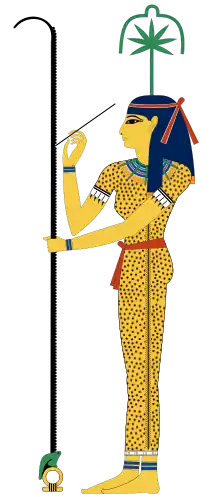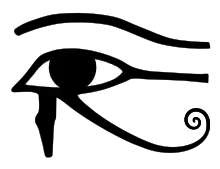Seshat
Seshat, under various spellings,[2] was the ancient Egyptian goddess of wisdom, knowledge, and writing. She was seen as a scribe and record keeper, and her name means she who scrivens (i.e. she who is the scribe), and is credited with inventing writing. She also became identified as the goddess of accounting, architecture, astronomy, astrology, building, mathematics, and surveying.
| Seshat | |||||
|---|---|---|---|---|---|
 Seshat, depicted in a leopard skin, inscribing the years of reign for the king on the palm-leaf rib which served for tallying up the years and so had become the hieroglyph for "year".[1] | |||||
| Name in hieroglyphs | |||||
| Symbol | leopard skin, tablet, star, stylus | ||||
| Parents | Thoth and Maat | ||||
| Consort | Thoth (in some accounts) | ||||
| Part of a series on |
| Ancient Egyptian religion |
|---|
 |
|
|
In art, she was depicted as a woman with a seven-pointed emblem above her head. It is unclear what this emblem represents.[3][4][5][6] This emblem is the origin of an alternate name for Seshat, Sefkhet-Abwy, which means "seven-horned".[7]
Mistress of the House of Books is another title for Seshat, being the deity whose priests oversaw the library in which scrolls of the most important knowledge were assembled and spells were preserved. One prince of the Fourth Dynasty, Wep-em-nefret, is noted as the Overseer of the Royal Scribes, Priest of Seshat on a slab stela. Heliopolis was the location of her principal sanctuary.
Usually, she is shown holding a palm stem, bearing notches to denote the recording of the passage of time, especially for keeping track of the allotment of time for the life of the pharaoh. She was also depicted holding other tools and, often, holding the knotted cords that were stretched to survey land and structures. She is frequently shown dressed in a cheetah or leopard hide, a symbol of funerary priests. If not shown with the hide over a dress, the pattern of the dress is that of the spotted feline. The pattern on the natural hide was thought to represent the stars, being a symbol of eternity, and to be associated with the night sky.
As the divine measurer and scribe, Seshat was believed to appear to assist the pharaoh in both of these practices. It was she who recorded, by notching her palm, the time allotted to the pharaoh for his stay on earth. Seshat assisted the pharaoh in the "stretching the cord" ritual. This ritual is related to laying out the foundations of temples and other important structures in order to determine and assure the sacred alignments and the precision of the dimensions. Her skills were necessary for surveying the land, to re-establish boundary lines after the annual floods. The priestess who officiated at these functions in her name also oversaw the staff of others who performed similar duties and were trained in mathematics and the related store of knowledge.
She also was responsible for recording the speeches the pharaoh made during the crowning ceremony and approving the inventory of foreign captives and goods gained in military campaigns. During the New Kingdom, she was involved in the Sed festival held by the pharaohs who could celebrate thirty years of reign.
Thoth, the reckoner of time and god of writing who was also venerated as a god of wisdom, was closely identified with Seshat, with whom he shared some overlapping functions. At times she was identified as his daughter, and at other times as his companion.
Emblem
| Two variations of Seshat's emblem in hieroglyphs |
|---|
The Seshat emblem is a hieroglyph representing the goddess Seshat in Ancient Egypt. As the emblem symbolizes this deity, it sits atop her head. The emblem was a long stem with a 7-petal flower on top and surmounted by a pair of horns; the archaic form had 7-petals (the vertical shaft as 8), (as a vertical, with two crossed lines-(4), as a 'star', and one horizontal-(2), giving 7+ the 1-vertical shaft), and surmounted by two enclosing sickle-shaped signs, two falcon-feathers on top.
The Seshat emblem in Egyptian is the name of Seshat (sš3t). It is thought her origins also involve the stars, and ancient Egyptian astronomy.
Palermo Stone usage
The famous 24th century BC Palermo Stone has multiple uses of Seshat's emblem. It occurs on the obverse of the Palermo Piece (at Palermo Museum), 1 of the 2 large pieces of the 7—piece Palermo Stone. It is used on the obverse, Row III (of VI rows), and is used twice in King Year Record 34, and 40 of King Den. It is also used elsewhere on the stone for God Seshu,[8] the male counterpart of Seshat (Seshait or Sesha-t).[9]
The reading is approximately: "YEAR: To create (a) Statue for Seshait, Statue for Mafdet." (The King Year 34 register has the clearer of the two styles of Seshat Emblem, with larger spacing between the 2-vertical feathers. Note: the Gardiner font reads left-to-right; the Palermo Stone is written opposite: right-to-left. A large renpet (hieroglyph) for YEAR, precedes the register (forms its starting border).)
Iconographic example, Goddess Seshat
One famous example of the iconographic use of the Seshat's emblem is from Pharaoh, and Queen Hatshepsut's Red Chapel.
Gallery

 Ushabti box with hieroglyphs of Seshat's emblem
Ushabti box with hieroglyphs of Seshat's emblem Goddess Seshat, ca. 1919-1875 B.C.E., 52.129 Brooklyn Museum
Goddess Seshat, ca. 1919-1875 B.C.E., 52.129 Brooklyn Museum Seshat carved on the back of the throne of the seated statue of Rameses II in the Amun temple at Luxor. It dates from around 1250 BCE.[5]
Seshat carved on the back of the throne of the seated statue of Rameses II in the Amun temple at Luxor. It dates from around 1250 BCE.[5] Seshat. Same carving, full length
Seshat. Same carving, full length Seshat, at the Karnak Temple Complex
Seshat, at the Karnak Temple Complex
References
| Wikimedia Commons has media related to Seshat. |
| Wikimedia Commons has media related to Scribes. |
| Wikimedia Commons has media related to Seshat's emblem. |
- Seshat in Luxor. H. Peter Aleff. See also Huh (god).
- Including Safkhet, Sesat, Seshet, Sesheta, and Seshata.
- Wilkinson, Richard H. (2003). The Complete Gods and Goddesses of Ancient Egypt. Thames & Hudson. p. 166. ISBN 0-500-05120-8.
- In Search of Cosmic Order: Selected Essays on Egyptian Archaeoastronomy. Editors: Juan Antonio Belmonte, Mosalam Shaltout. Contributor: Zahi Hawass. Publisher: American University in Cairo Press, 2010. ISBN 9789774794834. In chapter 7 on page 197 it says, "The sign held by Seshat over her head has given rise to many attempts to offer an explanation for this rare feature, but none has yielded a definitive conclusion."
- Seshat and her tools. H. Peter Aleff. From his article: "Many Egyptologists have long speculated about the emblem which Seshat wore as her head dress. Sir Alan Gardiner described it in his still category-leading 'Egyptian Grammar' as a 'conventionalized flower (?) surmounted by horns'. His question mark after "flower" reflects the fact that there is no likely flower which resembles this design. Others have called it a 'star surmounted by a bow', but stars in the ancient Egyptian convention had five points, not seven like the image in Seshat's emblem. This number was so important that it caused king Tuthmosis III (1479 to 1425 BCE) to call this goddess Sefkhet-Abwy, or 'She of the seven points'." In the same article, Aleff himself describes the figure as "an accurate image of a hemp leaf".
- Egyptian Grammar (Dictionary). By Sir Alan Henderson Gardiner. ISBN 978-0900416354.
- Hart, George (2005). The Routledge Dictionary of Egyptian Gods and Goddesses, Second Edition. Routledge. p. 141
-
- Budge, 1920, (1978). An Egyptian Hieroglyphic Dictionary, p. 698a.
-
- Budge, 1920, (1978). pp. 697b-698a.
Further reading
- Budge, 1920, (1978). An Egyptian Hieroglyphic Dictionary, E.A.Wallace Budge, (Dover Publications), c 1978, (c 1920), Dover edition, 1978. (In two volumes, 1314 pp. and cliv-(154) pp.) (softcover, ISBN 0-486-23615-3)
